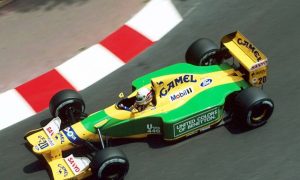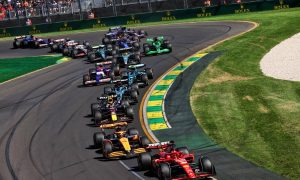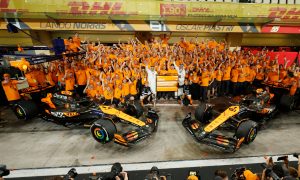F1i's Eric Silbermann speaks to Force India chief engineer Tom McCullough about the new start regulations being imposed at the Belgian Grand Prix
“You’re here to talk about the hot potato,” says Force India’s chief engineer Tom McCullough, as I’m marched into the team garage by ever-helpful team PR, Will Hings. Hot potato yes, but not the frites for which Belgium is famous. One of the main talking points this week, apart from Kimi Raikkonen’s re-signing for Ferrari, is the change to the rules regarding information that can be passed from pit wall to the driver while he sits on the grid, staring at the back of his grid girl’s legs.
The buzz phrase is ‘clutch bite point’, which you may recall from your driving lessons as the moment when you balance the forward motion of the car, holding it stationary using the clutch and the throttle. It’s a handy skill to make a hill start without using the handbrake, a component not actually fitted to Formula One cars.
The Belgian GP is the first race at which the engineers cannot instruct their drivers to move a switch on the wheel to effect a change in the bite-point, based on data gathered during the formation laps. That might not sound too important but according to the Cassandras of Clutch, this small ruling could lead to yet another Spa startline mega carambolage, with drivers facing three possible scenarios: making a good start, a bad one or stalling on the grid.
Why? I hear you ask. Well, it’s another idea originally instigated by the infamous F1 Strategy Group, which reckoned race fans want the drivers to be to be in control of their own destiny, rather than acting like lab-chimps prompted to press buttons by pit wall boffins.
Once the idea was ratified by the FIA – with more draconian radio restrictions to come next year – it was, as usual, the overworked team engineers who had to deal with the fall out. It’s not what you want mid-season. Just imagine the chaos if you changed the off-side rule in football for the final stages of the Champions League. McCullough admits it was a headache, especially with no testing.
“There’s a certain amount you can do on a simulator and on a virtual car, but there’s nothing like going out on track, trying these different procedures,” he tells F1i. “The current cars are quite complicated to drive and the drivers become attuned to what they need to do for starts, for energy recovery and all these different things. Just changing one of them makes life quite difficult.”
Getting the bite point right is fundamental to making a good start and with no previous restrictions, engineers had designed clutch componentry and developed an operating strategy that allowed them and the drivers to fine tune it right up to the moment before the lights went out, based on what they have seen on the formation laps.
“It means that now, using one of the clutch paddles (on the back of the wheel) they need to feel the engagement of the clutch for themselves a lot more, rather than being told how to set it,” adds the Force India engineer.
Evolving levels of grip was one of the main factors that affected how an engineer wanted his driver to set the clutch bite point on the grid, but now they will stare helpless and silent at the telemetry screens watching their drivers possibly make completely wrong choices as they are about to manage their starts.
Of course, as is so often the case, it’s the same for everyone.
"I fear that this change to the regulations is going to put some unfortunate randomness into the start performance"
“On a Formula One car, you have two clutch paddles, so you can fully disengage one, holding the other one at the point you feel is roughly right for the conditions and then when the lights go out, you dump the first paddle and it should take you straight to that bite point and you slowly release the second one,” continues McCullough.
“That’s the theory but the problem we are going to have now is that the hardware isn’t designed to be used in the way we are going to use it. If we had known this at the start of the year we would have designed a different clutch. I fear that this change to the regulations is going to put some unfortunate randomness into the start performance.”
And the former Sauber engineer believes the results could even be hazardous.
“I do fear it could be quite dangerous because everyone is always looking for the optimal performance. If it was just a case of getting off the line without gaining or losing position, then it would be quite safe,” he says. “But everyone’s going to try and do really well, as we are all competitive people.
“When you have too much wheelspin it’s generally not that dangerous, as we have seen in recent races. What worries me the most is an anti-stall situation, leading to a car stationary on the grid. A lot of factors leading to that are not under the control of the driver: he doesn’t know what temperature the clutch is at and when the race actually starts the temperature has changed and so too therefore has the bite point. There are so many factors involved. We have seen this year that, even with all the aids, there have been some shockers at the start.”
This rule change seems like a lot of effort for little reward. The drivers should be in charge of their own destiny, so ban all the start aids and let the grand prix stars prove their worth, controlling the start and subsequent wheel spin with clutch and throttle control. If you want to ban radio messages, prevent engineers telling their drivers to “keep pushing,” and other forms of verbal encouragement. For goodness sake, they’re meant to be the best drivers in the world; they ought to manage to keep themselves motivated for 90 minutes every other Sunday.
Click here for a gallery of the biggest crashes at Spa-Francorchamps
Keep up to date with all the F1 news via Facebook and Twitter










